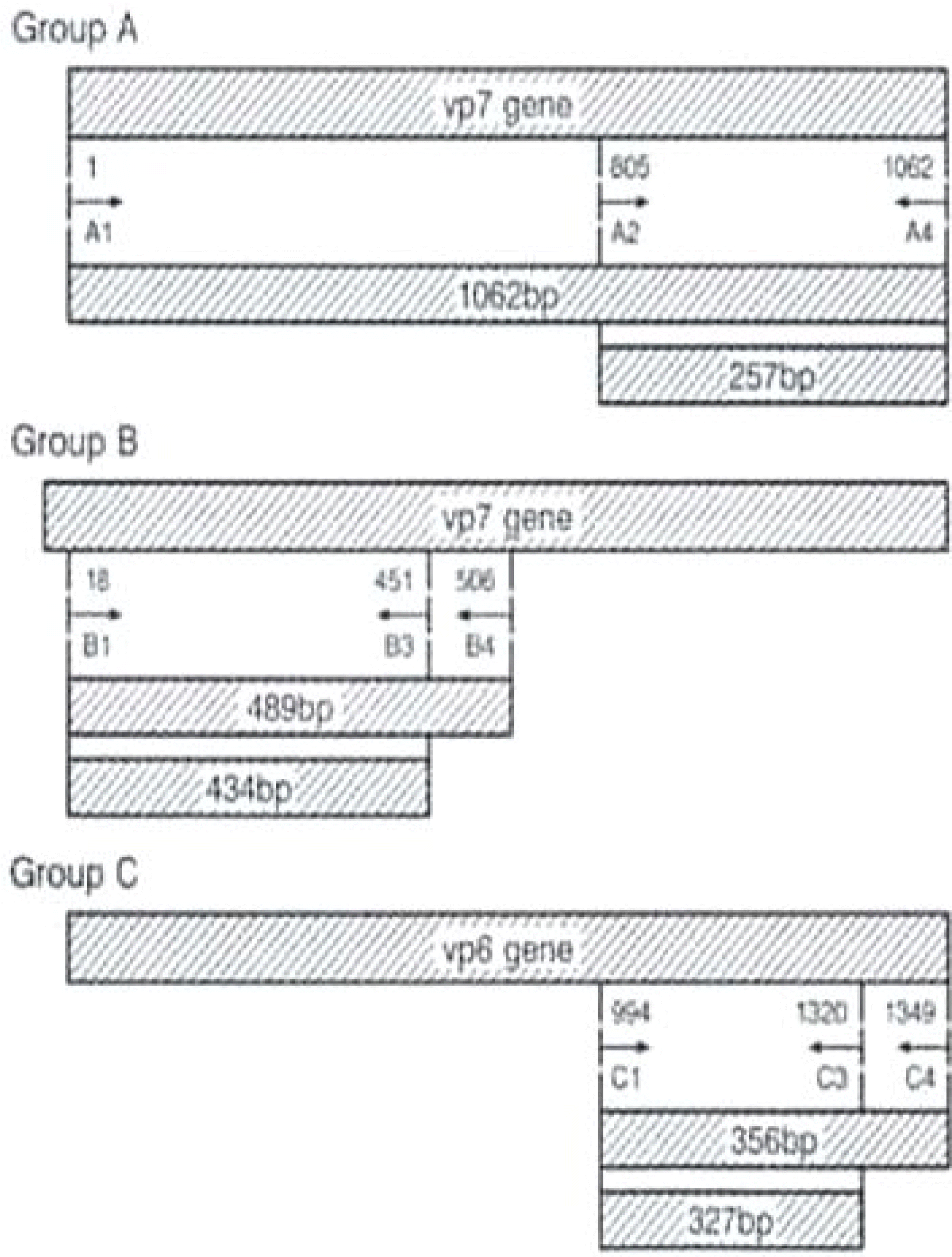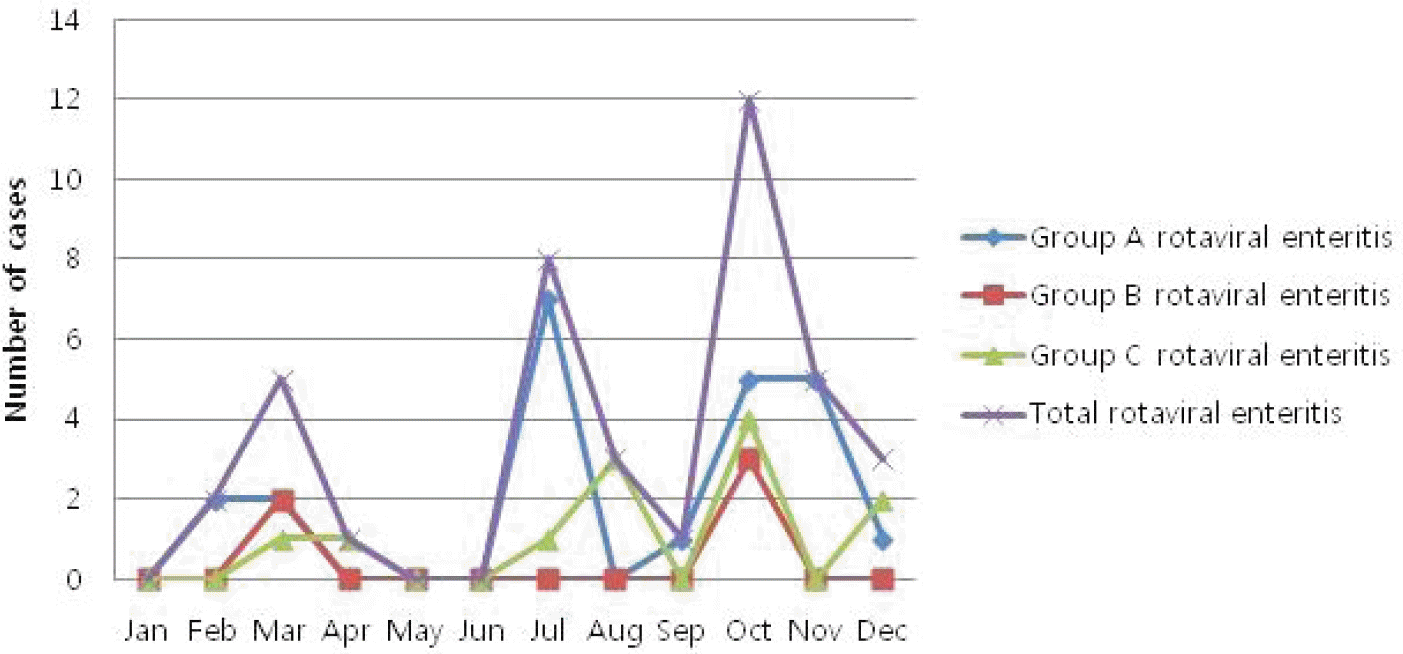Abstract
Purpose
The aim of this study is that the prevalence of rotavirus infection was evaluated by each group and clinical features of group A, B and C rotaviruses infections were described respectively to compare one with another. Methods: Between January 2010 and December 2010, we enrolled a group of children below 10 years of age admitted for management of acute diarrhea at the Catholic University of Korea Bucheon St. Mary's Hospital. A total of 310 stool samples documented to be free of common bacterial pathogens were collected from children with diarrhea. The presence of group A, B or C rotavirus is indicated by amplification of DNA segments of the expected lengths after the first and second PCRs Results: In a total of 310 stool specimens, 40 (12.9%) specimens were positive for rotaviruses. These included 23 (7.4%) positive for group A, 5 (1.6%) for group B and 12 (3.9%) for group C rotaviruses. Group B rotavirus infected patients had significantly less diarrheas per day (group A: P=0.01, group C: P=0.01) and shorter duration of vomiting days (group A: P=0.03, group C: P=0.03) than those with group A and C rotaviruses infection respectively. All the group B rotaviruses had been isolated in March and October. Group C rotavirus infections were prevalent during late summer and early winter and peaked in October. Conclusion: These findings indicate that group B and C rotaviruses are notable causes or the contributing causes of diarrhea among infants and children in Korea.
References
1. Kapikian AZ, Hoshino Y, Chanock RM. Rotaviruses. Knipe D, Howley P, Griffin D, MArtin M, Lamb R, Roizman B, Straus S, editors. Fields virology. 4th ed.Philadelphia: Lippincott Williams & Wilkins;2006. p. 1787–822.
2. Saif LJ, Jiang B. Nongroup A rotaviruses of humans and animals. Curr Top Microbiol Immunol. 1994; 185:339–71.

3. Krishnan T, Sen A, Choudhury JS, Das S, Naik TN, Bhattacharya SK. Emergence of adult diarrhoea rotavirus in Calcutta, India. Lancet. 1999; 353:380–1.

4. James VL, Lambden PR, Caul EO, Cooke SJ, Clarke IN. Seroepidemiology of human group C rotavirus in the UK. J Med Virol. 1997; 52:86–91.

5. Riepenhoff-Talty M, Morse K, Wang CH, Shapiro C, Roberts J, Welter M, et al. Epidemiology of group C rotavirus infection in Western New York women of childbearing age. J Clin Microbiol. 1997; 35:486–8.

6. Steele AD, James VL. Seroepidemiology of human group C rotavirus in South Africa. J Clin Microbiol. 1999; 37:4142–4.

7. Iturriza-Gomara M, Clarke I, Desselberger U, Brown D, Thomas D, Gray J. Seroepidemiology of group C rotavirus infection in England and Wales. Eur J Epidemiol. 2004; 19:589–95.

8. Maunula L, Svensson L, von Bonsdorff CH. A family outbreak of gastroenteritis caused by group C rotavirus. Arch Virol. 1992; 124:269–78.

9. Jiang B, Dennehy PH, Spangenberger S, Gentsch JR, Glass RI. First detection of group C rotavirus in fecal specimens of children with diarrhea in the United States. J Infect Dis. 1995; 172:45–50.

10. Cunliffe NA, Dove W, Jiang B, Thinwda Cert BD, Broad-head RL, Molyneux ME, et al. Detection of group C rotavirus in children with acute gastroenteritis in Blantyre, Malawi. Pediatr Infect Dis J. 2001; 20:1088–90.

11. Adah MI, Wade A, Oseto M, Kuzuya M, Taniguchi K. Detection of human group C rotaviruses in Nigeria and sequence analysis of their genes encoding VP4, VP6, and VP7 proteins. J Med Virol. 2002; 66:269–75.

12. Sanchez-Fauquier A, Roman E, Colomina J, Wilhelmi I, Glass RI, Jiang B. First detection of group C rotavirus in children with acute diarrhea in Spain. Arch Virol. 2003; 148:399–404.
13. Phan TG, Nishimura S, Okame M, Nguyen TA, Khamrin P, Okitsu S, et al. Virus diversity and an outbreak of group C rotavirus among infants and children with diarrhea in Maizuru city, Japan during 2002–2003. J Med Virol. 2004; 74:173–9.

14. Rahman M, Banik S, Faruque AS, Taniguchi K, Sack DA, Van Ranst M, et al. Detection and characterization of human group C rotaviruses in Bangladesh. J Clin Microbiol. 2005; 43:4460–5.

15. Steyer A, Poljsak-Prijatelj M, Bufon T, Sedmak M, Vidmar L, Mijovski JZ, et al. First detection of group C rotavirus in patients with gastroenteritis in Slovenia. J Med Virol. 2006; 78:1250–5.

16. Estes M, Kapikian A, Knipe D, Howley P. Rotaviruses. Knipe D, Howley P, Griffin D, Lamb R, Martin M, Roizman B, Straus S, editors. editors.Fields virology. 5th ed.Philadelphia: Lippincott Williams & Wilkins;2006. p. 1917–74.
17. Rodriguez WJ, Kim HW, Arrobio JO, Brandt CD, Chanock RM, Kapikian AZ, et al. Clinical features of acute gastroenteritis associated with human reovirus-like agent in infants and young children. J Pediatr. 1977; 91:188–93.

18. Rahman M, Hassan ZM, Zafrul H, Saiada F, Banik S, Faruque AS, et al. Sequence analysis and evolution of group B rotaviruses. Virus Res. 2007; 125:219–25.

19. Sanekata T, Ahmed MU, Kader A, Taniguchi K, Kobayashi N. Human group B rotavirus infections cause severe diarrhea in children and adults in Bangladesh. J Clin Microbiol. 2003; 41:2187–90.

20. Gouvea V. PCR detection of rotavirus. Persing DH, Smith TF, Tenover FC, White TJ, editors. editors.Diagnostic molecular microbiology: principles and applications. Washington, DC: American Society for microbiology;2006. p. 383–88.
21. Moon S, Humphrey CD, Kim JS, Baek LJ, Song JW, Song KJ, et al. First detection of Group C rotavirus in children with acute gastroenteritis in South Korea. Clin Microbiol Infect. 2011; 17:244–7.

22. Mitui MT, Bozdayi G, Dalgic B, Bostanci I, Nishizono A, Ahmed K. Molecular characterization of a human group C rotavirus detected first in Turkey. Virus Genes. 2009; 39:157–64.

23. Castello AA, Arguelles MH, Villegas GA, Olthoff A, Glikmann G. Incidence and prevalence of human group C rotavirus infections in Argentina. J Med Virol. 2002; 67:106–12.

24. Kuzuya M, Fujii R, Hamano M, Nishijima M, Ogura H. Detection and molecular characterization of human group C rotaviruses in Okayama prefecture, Japan, between 1986 and 2005. J Med Virol. 2007; 79:1219–28.

25. Castello AA, Arguelles MH, Rota RP, Humphrey CD, Olthoff A, Gentsch JR, et al. Detection and characterization of group C rotavirus in Buenos Aires, Argentina, 1997–2003. J Med Virol. 2009; 81:1109–16.

26. Kuzuya M, Fujii R, Hamano M, Ohata R, Ogura H, Yamada M. Seroepidemiology of human group C rotavirus in Japan based on a blocking enzyme-linked immunosorbent assay. Clin Diagn Lab Immunol. 2001; 8:161–5.

27. Banyai K, Jiang B, Bogdan A, Horvath B, Jakab F, Meleg E, et al. Prevalence and molecular characterization of human group C rotaviruses in Hungary. J Clin Virol. 2006; 37:317–22.
28. Luchs A, Morillo SG, de Oliveira CM, Timenetsky Mdo C. Monitoring of group C rotavirus in children with acute gastroenteritis in Brazil: an emergent epidemiological issue after rotavirus vaccine? J Med Virol. 2011; 83:1631–6.

Table 1.
Primers used for RT-PCR
Table 2.
Comparison of Clinical Features of Patients Infected by Group A, B and C Rotaviruses




 PDF
PDF ePub
ePub Citation
Citation Print
Print




 XML Download
XML Download